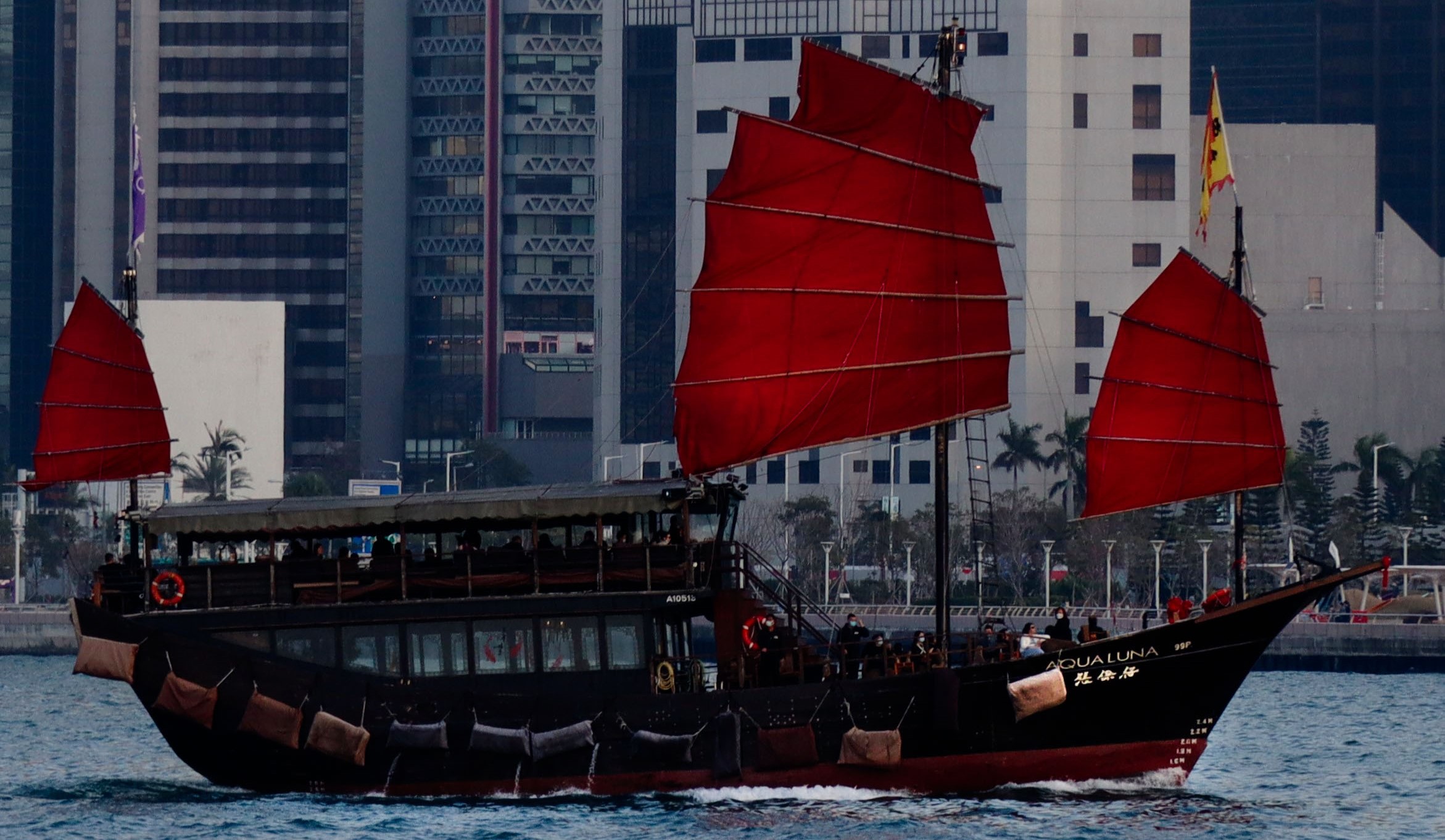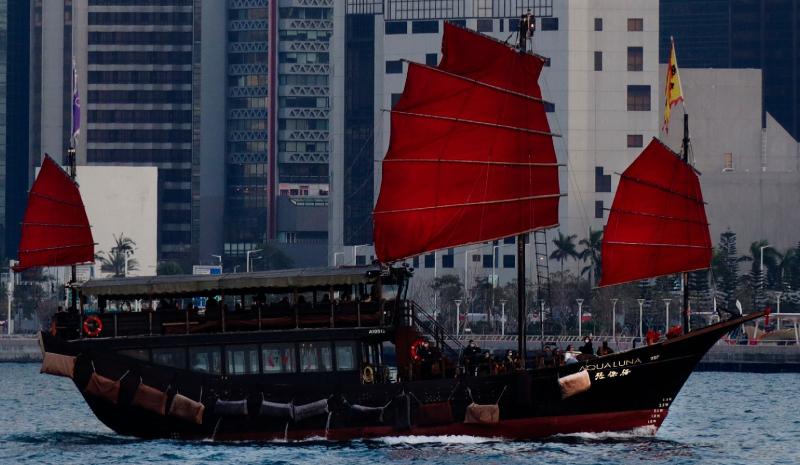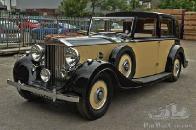Chinese Junks: Emperors of the East
By: The Shipyard

Chinese Junks: Emperors of the East

The Age of Sail - those three glorious centuries of European domination of the oceans - are considered by many on my side of the globe as the grass roots of modern navigation. But few of us realize that, before the 16 th century, the Old World's maritime technology lagged behind the hegemons of the Indo-Pacific: the Arabian dhow , the Austronesian proa (or prahu ), and the formidable Chinese junk .
In 1295, when Marco Polo spoke of six-masted Chinese ships with sternpost rudders and watertight bulkheads, his fellow-Venetians thought the desert sun and foreign diets must have muddled the traveler's mind. We can hardly blame the average European for doubting Polo's narrative - merchant galleys at the time paled next to the ocean-going junks of the Song and Yuan Dynasties, with only half the size and none of the technical sophistication of the Chinese vessels.

Chinese junks in Guangzhou, circa 1880. (Credits: Lai Afong)
Six centuries later, though, a modest fleet of British warships decimated the Qing Dynasty's entire navy, leaving the shattered carcasses of imperial junks smoldering in the Pearl River Delta, like a symbol of a disintegrating great power. Now, the jaw-dropping story of the great junk is all but forgotten. How did this magnificent ship evolve to dominate the Far East, and what led to its grotesque demise?
A Design Multiverse
Contrary to popular belief, the term junk does not refer to one specific type of boat. Originating from the Teochew dialect and later picked up by the Portuguese, the word zung simply translates as "ship". And much like its name, the vessel itself was never limited to a single design. Although the classic silhouette included the iconic bat-wing sails, a flat-bottomed hull with a pronounced curve, and a stern-mounted rudder, junks adopted numerous design variations, depending on period, region, purpose, available materials, and foreign influences.

Rudder designs of ocean-going junks (top) vs. those of river junks (bottom). (Source: Louis Audemard, Juncos Chineses, Macau, Museu Maritimo de Macau )
Perhaps the most visible element of a junk were the battened sails, which opened and closed much like a Chinese fan. Although heavy and cumbersome to raise, these sails lowered and folded within seconds, requiring only a skeleton crew - a stark contrast with Western vessels, where tack-change called for many hands on deck. Fabric sails first appeared as late as the 12 th century, with earlier vessels using bamboo mats instead.
Unlike other regions in the world, where ship hulls evolved from dug-out boats, naturally adopting keels and pointed sterns, the predominant vessel in early Chinese navigation was the U-bottomed raft. The roots of its characteristic shape stem from the country's vast and challenging geography - the ancient Chinese first explored the potential of their navigable rivers, later moving to the shallow coastline of the Bohai Sea, the Yellow Sea, and the East China Sea. Only the highest cargo capacities made such distances economical, while the shallow and silty waterways demanded minimal draft; hence, the curved, flat hull performed equally well on the river and out at sea.

Raft in the Ya River. (Source: Jean Poujade, La Route des Indes et ses Navires)
In contrast, the South China Sea was both deeper and more accessible for international trade, leading to the adoption of foreign hull designs, like the tapered bows of dhows and proas . A curious monument of this exchange of ideas were the large eyes, painted onto the bows of imperial junks, much like the ships of Ancient Egypt and Greece. In fact, historians believe this was their precise origin, with Muslim-Arab traders acting as intermediaries between the Mediterranean and the Far East.
Another curious and fascinating feature of the hull was hidden inside - watertight compartments. Yes, the technology that failed the Titanic and saved countless other vessels was devised by the brilliant shipbuilders of the Middle Kingdom, inspired by the inner structure of a bamboo stalk. While European and Arab travelers marveled at this invention in the 15 th century, bulkheads had already been a mainstream feature of Chinese junks for at least a millennium.

Chinese junk boat under construction. (Credits: Huang Liang)
But the most revolutionary Chinese innovation was arguably the stern-mounted rudder. This invention steered junks as early as the 1 st century AD, a good thousand years before the invention of its pintle-and-gudgeon European relative. Western shipyards struggled for many years, as the tapered sterns of their vessels made axially mounted steering a challenging task. It was not until the 14 th century and the development of the vertical sternpost, when European navies discarded the side-rudder and sailed out on the open ocean with new vigor.
The Pinnacle: Junks Go Global
The quintessential Chinese ship reached its Golden Age in the early 15 th century. In a time of global innovation and maritime discovery, the spirit of exploration ignited the ambitions of the early Ming Dynasty. In 1405, the far-sighted Yongle Emperor assigned to his trusted court-eunuch Zheng He a task as grueling as it was glorious - to head a massive naval expedition with the goal to assert Ming dominance over the Indian Ocean trade and establish a transcontinental tributary system, all the way to East Africa.
Described by his contemporaries as "walking like a tiger", Admiral He sailed from the port of Liujiagang in a fleet that fitted his assertive swagger. Of the 317 junks of Zheng He's first expedition, the most splendid (and controversial) were the "Treasure Ships", reported by some sources to have reached 417 feet (127 m) in length. Each of these marvels of pre-modern shipbuilding housed hundreds of passengers, including navigators, doctors, translators, soldiers, and bureaucrats. This first tributary expedition took the magnificent Chinese delegation to Southeast Asia, the Malay Archipelago, India, Arabia, and the Horn of Africa. The Yongle Emperor sponsored seven tributary voyages, for which the Nanjing shipyards churned out two thousand seagoing junks.

The Return of Zheng He. (Artist: Vladimir Kosov)
Over the six centuries since then, however, the dispute about the size of Zheng He's junks has been as heated as the praise. Qing-Dynasty historians, who first lauded the astonishing lengths of the Treasure Ships, also reported impressive dimensions for European vessels, which have since then been proven as strongly exaggerated. Western studies thus suspect that the imperial junks measured as little as 230 ft (70 m).
The debate gets even blurrier due to variations in historic Chinese units, like zhang and chi . One chi , for example, could measure anywhere between twenty-five and thirty-five centimeters. Modern Chinese scholars, however, consider the value of a Fujianese chi as the geographically closest to the Ming-Dynasty, arguing that He's flagship must have been 425 ft (130 m) long, making it the second largest wooden sailing ship in history (after the American schooner Wyoming ).

Shipyard building traditional wooden junks at Cheung Chau, 1973. (Credits: Karsten Petersen)
The Phoenix That Never Rose from the Ashes
Zheng He's naval triumph was not to last. Toward the end of his reign, the Yongle Emperor deployed much of the country's resources north of the Great Wall, against the remnants of the fallen Mongol dynasty. This massive land campaign not only put an end to China's maritime expansion but also contributed to centuries-long isolation, choking international trade, and leading to inevitable naval decline.

Stamp from Indonesia commemorating Zheng He's 600th Anniversary. (Source: Post of Indonesia)
Tragically, the Ming never suspected the far-reaching legacy of this isolationism - sealing the empire's borders strangulated not just the flow of products, but the exchange of ideas. As the Qing Dynasty maintained their own restrictive policy under the Canton System, China remained cut-off from the world in an era of unseen technological progress. By the time the British Navy arrived in the Pearl River Delta to wage the Opium Wars, the mighty Qing empire and its opulent fleet of junks were hopelessly obsolete. By 1875, the Imperial Chinese Navy replaced the last remaining war junks with foreign-built steamships.
Contrary to expectations, the junk survived well into the 20 th century, making a spectacular and gruesome last stand in the 1950 Battle of Hainan Island, where the Red Army deployed 318 ramshackle junks in an epic amphibious assault against Nationalist forces. Imagine a deadlier D-Day, but with wood and sail, rather than steel and diesel!

Junks at the Battle of Hainan, 1950. (Source: Wiki Commons)
Across the border in British Hong Kong, numerous junks plied the waterways in and around the colony all the way until the 1970s, when the Tanka (boatpeople) community agreed to scrap their quaint floating homes and dissolve into Hong Kong's concrete maze.

Chinese Junks in Hong Kong's Yaumatei Typhoon Shelter, 1972. (Credits: Karsten Petersen) Chinese junk entering Victoria Harbour, Hong Kong, 2 April 1977. (Credits: Karsten Petersen)

Chinese junk entering Victoria Harbour, Hong Kong, 2 April 1977. (Credits: Karsten Petersen)
No politics, no religion, no instagrams, and commentary must be civil. The ToS and the CoC will be enforced, and anything that the administrator deems to be offensive will be deleted. YouTubes, videos and images that the administrator is unable to open must be described and explained or they will be deleted.








Actually, I've never seen a junk. I think their sails are quite unique, and do set them apart from ships of other nations.
I wouldn't be surprised if Biden were to ban the importing of Chinese junks on the basis of their being a threat to America's national security.
It seems nobody is interested in Chinese junk. :LOL